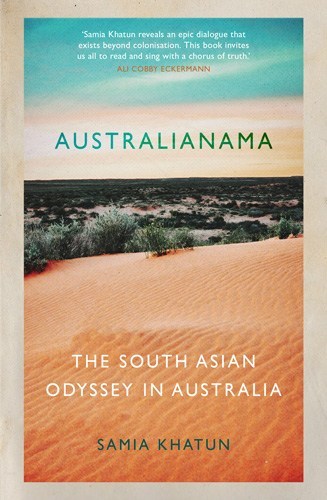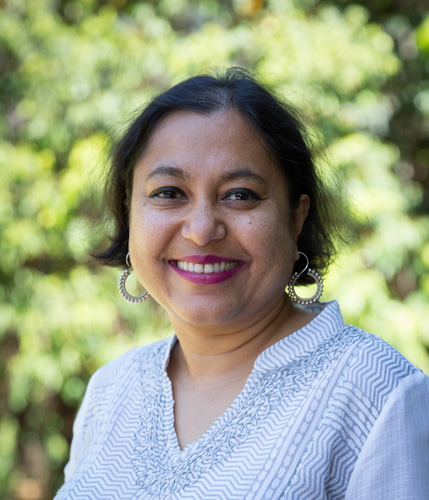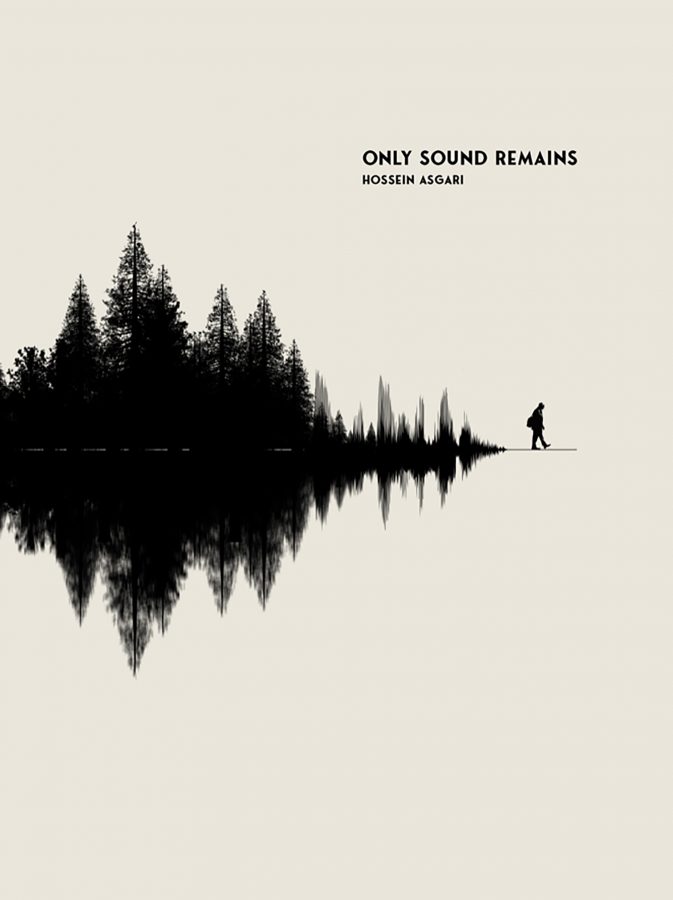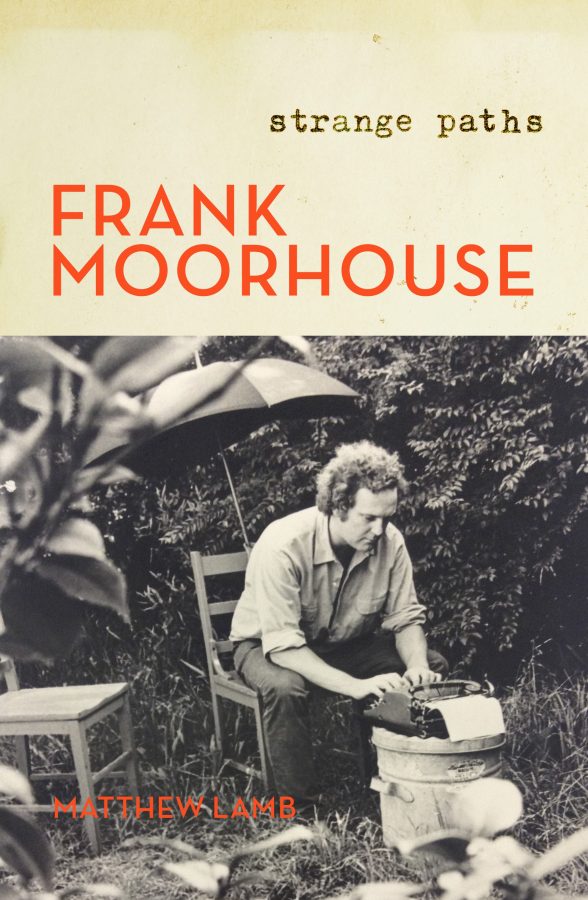A Book of Books:
Centred on the arrival narrative of a single book, the Kasasol Ambia (Stories of the Prophets), in a mosque built in 1887 at the edge of the desert in Broken Hill, historian Samia Khatun’s Australianama, is, like the object of its inquiry, a book of books. The mystery of ‘who/what’ brought this 500-page compendium of Bengali Sufi poetry, printed in eight volumes between 1861 and 1895 in Calcutta, to this outpost of empire down-under, launches Khatun into a decade-long odyssey from Sydney to Dhaka, Perth to Calcutta, Melbourne to Lahore, and deep into the archival reserves of nineteenth-century colonialism. Setting out to tell the story of the Afghan Express, that operated as ‘a crucial adjunct to colonial industries throughout Australian deserts’ and that replaced ‘the arteries of an Aboriginal economic landscape’, Khatun re-c/sites an epic tale of cameleers, hawkers, journeymen, and associated South Asian migrants to this unceded land. Khatun offers us not just a ‘history of South Asians per se, but rather an account of the dense conjectures of knowledge traditions that South Asians arrived in when they stepped into Aboriginal land in the era of colonial rule’. Using non-English language texts, Australianama’s remit is to challenge the Enlightenment ‘knowledge relations’ that reduced colonised people’s epistemologies to mere artefacts and placed them into progress narratives in which they could only ever be backward and die out, with ‘no place in an imagined future’. Instead, Khatun spins a rollicking tale that unveils a capacious repertory of knowledge about the South Asian footprint in Australia, transported over the Indian Ocean, and its intimate correlation to Aboriginal gnostic worlds.
In this journey, Khatun proves herself to be the qissa goh, a story teller of her own roots, of formidable mettle, wherein qissas also become the chroniclers of an entire people. Like Attia Hossain, another woman in another time, who said, ‘Here I am, I have chosen to live in this country which has given me so much; but I cannot get out of my blood the fact that I had the blood of my ancestors for 800 years in another country’, Khatun too traces an epistemological bloodline through generations of South Asians who have passed through this land and were just as consequential in its settlement narratives.
Carrying embedded knowledge traditions from other temporalities and geographies of multitudinous proportions, traversing an insular empire that sought to create a singular colonial mentality through conquest, the lineage that Khatun invokes can be traced back to the venerable medieval Persian practice of dastan goi, which found its metier in the Indian subcontinent in the Urdu oral form. In true syncretic subcontinental fashion, Khatun combines this orality with another artform, that of Hindustani classical music, again genealogically connected to Persia, whereby Vrindavani Sarang sings the raga of Radha’s endless quest for Krishna’s flute that has fallen silent, only for the listener to realise that she herself was the flute on his lips. Such a conceit of the seeker and the deity, the teller and the story, is a staple of Sufi poets, trickster street performers of aiyyari and Hindustani artistes, a conceit that then becomes a synecdoche for a world that began to be populated on Aboriginal country by these South Asian sojourners, about whom the question has often been asked, were they Pioneers or Settlers?
Khatun’s primary contention is that just as this continent was never terra nullius – but was instead held in custodianship by Indigenous peoples for millennia, who knew how to read the land to tell its tale – the subcontinental travellers who arrived on it also carried along giant story-telling traditions that helped them navigate these journeys across uncharted waters and shapeshifting sands. Channelling Deborah Bird Rose’s methodological intervention into ‘place-oriented research’, Khatun seeks to redress erasures that mark the subcontinental presences on this continent, thereby unequivocally locating South Asians within multiple imaginative geographies of ‘living things whose tracks cross a given place’. These tracks are to be traced across the Indian Ocean in a thriving nineteenth-century Australia-India trade. Khatun cites a robust body of recent scholarship on the Indian Ocean that increasingly imagines this site as a ‘liquid continent’, a ‘theoretical terrain, a geographical space, and a historical network of human interconnectedness’ as well as a ‘site of epistemic struggle’.
What is in a Nama?:
Read as fluid interconnectedness and epistemic contestation, Australianama is a chronicle of this mighty oceanic passage that leads to the coming-into-being of Australia, like the great epic annals of the Farsi empire, the Shahnama, and of the Mughal emperors, Baburnama and Akbarnama. As the curators of the Metropolitan Museum of Art write:
With its interplay of lore and history, the Shahnama offers models of conduct and rulership that inspired numerous generations of rulers. In addition to being a great work of literature, in fact, the poem can also be considered a successful example of ‘mirror for princes,’ a popular genre in the medieval and early modern Islamic world intended for the education and edification of rulers. The teachings and moral exempla offered by the virtuous kings and paladins of the Shahnama are among the aspects that explain its great success throughout history.
Australianama narrates – like these other namas – art and anthropology, lore and legend, precept and philosophy, codes of conduct and culture, and lessons in survival and sustenance, for those who set out from their homes to ‘master’ the waters and ‘harness’ the land, words that are also the paternalistic handmaiden to the ideological vocabulary of colonial capital. In this quest, Khatun’s opus provides an entry-point into alternative theories of knowledge that South Asians brought with them, in belongings like the Kasasol Ambia, a curiosity mistaken for the Quran, which colonial record-keepers were unable to decipher as anything but dead artefacts in the museum of Australian national history.
In Khatun’s thaumaturgy, the book of books becomes an epistemological treasure trove for the seeker on paths unknown; in this case, the earliest Muslims in the camel trade that became the critical technology of colonial mercantile inland traffic. Interpreted correctly, through the Sufi logic that animates the Kasasol Ambia, listeners of what is quintessentially an oral text that has to be recited and heard, are scripted into narrative tropes that remind them of where they have come from and guide them into where they have arrived. Khatun further argues that the call and answer structure of such aural forms provides a parallel to Aboriginal historiographical traditions and frame-tales ‘housing stories that continue to change, live and transform from telling to telling’. That these oral/aural genres incorporate a musical cadence, which in itself shapes their modalities of delivery and reception, ensures their longevity and survival; the chronicles pass from generation to generation through repetitions, re-tellings, re-inscriptions, re-imaginings, and revisions.
By parsing the multi-source, multilingual components of the Kasasol Ambia, thereby revealing its generative creativity and enormous imaginative capaciousness, Khatun shatters ‘a long-influential hegemonic story about the incoherence of Perso-Arabic poetic traditions’ that lies at the heart of Anglophone ‘knowledge relations’. She shows us how the colonial act of ‘disciplining’ South Asian and Aboriginal storytelling traditions is but to ‘rob the[ir] poetry of the ability to perform its purpose—to imaginatively transport people to the past’. Using interpretive methodologies like Michel Foucault’s ‘subjugated knowledges’, Carlo Ginzberg’s ‘intuition… inference’, and Lorenzo Veracini’s ‘anticipatory geographies’, Khatun transports us to the ‘epistemological terrains on which past South Asians stood across the Indian Ocean rim’. Australianama thus performs the elucidatory function of an isnad, ‘a footnoting strategy that underpins truth-claims in Muslim historiography’.
Through the stories of the lascars, traders, hawkers, and chikanwallas, a veritable moving cast of characters who came to be known as ‘Afghans’ in the merchant commerce that kept empire afloat, Khatun weaves stories-within-stories-within-stories of South Asians who not only brought with them goods and commodities, but entire architectures of knowledges and historiographical methods that were scripted into interlocking frame narratives, and that, in turn, inscribed them – the listeners – into their own journeys. Because the Kasasol Ambia was a heterogenous conspectus that commingled Farsi Sufi texts with ‘Indic’ characters from the itihas-purana tradition (iti ha asa, literally ‘so indeed it was’ – i.e. a kind of recounting of time, space, and humanity), it also provided a contrast to the singular progress narratives of colonialism, and granted these Asiatic immigrants, who were increasingly falling on the wrong side of a constructed global colour line, a source of meaning-making techniques and a ‘discursive terrain that was not resistant to, but rather resilient against’ racist essentialising strategies. It is at this site of anti-racist utterance that South Asian story-tellings stand as embodied parallels to Indigenous narratologies; both traditions furnishing multiple ways of hearing, interpreting, understanding, absorbing, and passing on, knowledge.
There is a photograph among others in the inset section of the book: it shows waves of sand upon which are drawn interlinked dashes with a red pen. The photos preceding this one show individual traces of desert creatures that Khatun is tutored in ‘reading’ by Reg Dodd, chairman of the Arabunna People’s Committee in Marree, one of the sites where the tracks of ‘Afghan’ settlers and Aboriginal custodians met. The proliferation of these animal tracks thus begin to reveal other extant imprints that could have circumnavigated these ever-changing sand routes; they challenge the ‘logic of “blank spaces” that continues to underpin the most powerful settler institutions today’. Citing Patrick Wolfe, Khatun reminds us that these tracks put to lie the ‘cartographic genocide’ committed on Indigenous People’s lands and lives, tracks that are only visible to, and interpretable by, eyes that are trained in reading the pages of a continually transforming desert-scape. In undertaking this education, Khatun urges us towards other forms of learning that are necessary to understanding any site across time.
It might be tempting to say that Khatun re-invigorates the way academic research in the various colonial disciplines can be imagined: anthropology, ethnography, geography, history. It might be tempting to assess her work as just another supplement to the work of Australian anthropologists, ethnographers, geographers and historians, who either buttress or question white colonial settlement and leave it at that. Khatun’s commission is far more ambitious; in her own words, this book ‘challenges the suffocating monolingualism of the field of Australian history’. What she so deftly accomplishes is the almost impossible task of working from inside imperial intelligence (in all senses of the word), but thinking from traditions outside them, bringing entire repositories of knowledge from epistemes not accorded legitimacy by hegemonic codifications of colonial world-making. She performs the unlearning from inside the teaching machine that many a postcolonial scholar attempts but few succeed, and poses an enormous methodological challenge to the discipline of history as a mechanism of colonial authority. She manages to hear the country, to listen to its undulations and the songs of the peoples who walk on its tracks, who follow other creaturely tracks, and then make their own. As the lessons from Dodd make evident, each track carries its own story that attests to these creaturely presences, however brief or continuous, on the ever-mobile and mutating countenance of the land, land that always was, and always will be….
While learning to read country, Khatun brings us names of Indigenous peoples, place names, languages, re-incorporating them seamlessly into a land that was never ceded and remains in traditional custodianship today. She tells us about the first camel depot established at Beltana in 1866, ‘with thirty-one South Asian men and 124 camels from Karachi’ in the ‘country of Adnyamathana people—descendants of Kuyani, Bilaluppa, Jadliaura, and Wailpi families’. This is no lazy listing off of names: Khatun acknowledges, without any kind of self-congratulatory artifice or redeeming saviour consciousness, and pays respect to the sites that Indigenous peoples shared with these new arrivants from what is now known as South Asia or the Indian subcontinent variously. Khatun’s key sources are vast Indigenous libraries of memory and story-telling, but she notes how ‘Aboriginal people very rarely feature in these South Asians’ stories about Australia’ thereby replicating ‘the asymmetrical schemas of seeing in Australian colonial settlements’ (emphasis mine). She does not resile from the admission that in their travelogues and sojourners’ tales, South Asians too replicate ‘colonial discourse in their structured omission of Aboriginal people’. This is a cautionary directive, no doubt, to succeeding and contemporary subcontinental migrations to Indigenous country, to know, acknowledge and remember the custodians of the land that welcomes them.
The Shimmer of a Pearl OR Pearls before an Empire:
Art historian Natasha Eaton, in her work on photography during British colonialism in South Asia, ruminates upon oceanic imagery like conch shells and pearls, mediated by the theories of Walter Benjamin, Christopher Pinney, and Michael Taussig. Commenting specifically on the work of contemporary Malaysian/Indian-Australian artist, Simryn Gill, Eaton observes:
Informed by the rhetoric of bibliomancy, Gill either mines second-hand bookstores and flea markets for works by Fanon, Benjamin, and many provocative or playful writers (Borges et al.), or she cuts out from books sent as gifts. In both cases, she carefully destroys the text to fashion what she believes to be prescient constellations of words, which she carefully folds and folds over and over, to gesture towards the layers of both a pearl and the act of reading.
In a neat inversion of such post-historical illiteracy that marks some contemporary projects of un-knowledge for, in Eaton’s words, a ‘vanishing world of trading, melancholia and nostalgia’, a world that also finds a mirror in imperial museumology, Khatun shows us the intricate process by which other pearls may be intricately created in ‘different ways to the knower/known hierarchy that underpins Enlightenment epistemes’. She alludes to the story of Munshi Rezaulla, charged by his spiritual guide and publisher friend, with the task of translating stories of the prophets from Persian and Hindi to Bengali verse and tells us how he leaps into a sea to start threading a chain for the pearls he may discover, thereby becoming himself a pen dipped in ink within the sea of stories. This elaborate metaphor for translation, embodiment and auto-didacticism, signals to audiences that they are ‘entering an episteme that operates by revealing “whatever, whomever you search”’.
For Khatun, pearls emerge through her dramatis personae of Haji Mulla Meheraban, Mirza Khan, Gunny Khan, Anno Khan, Sher Khan, Moosha Balooch, Abdul Sattar, Bejah Dervish, names that seldom appear in captain’s logs of seafaring merchants, and even if they do, colonial interpretation does not allow any insight or meaning into their lives. Most lustrous amongst these pearls is an Urdu manuscript titled Lahore Ka Sindbad (Sindbad of Lahore, 1944), the unpublished English translation of which is ‘Memoirs of Khawajah Muhammad Bux, Australian Businessman’, commissioned by the intrepid entrepreneur who, at age eighteen, embarked on his first Indian Ocean voyage in 1875, and in the last decade of his life, invested his wealth in three monuments in Lahore known today as Australia Chowk or ‘Australia bazaar’. Khatun decodes Bux’s tri-continental travelogue of Oceanic travels through the eighth-century Abbasid Caliphate story-cycle structure of the seven voyages of Sindbad the Sailor, tenth-century mariners’ tales of the fabular island of gold, Waqwaq, the eleventh-century Sanskrit Kathasaritasagar (The Ocean of the Rivers of Stories), an Urdu public sphere where Punjabi love stories of the seventh-century Layla and Majnun and seventeenth-century Hir Ranjha circulate, as well as Hajj pilgrimage narratives down the centuries. This is an astonishing sleight-of-hand through which Khatun comprehensively demonstrates the magnitude of world knowledges travelling to colonial outposts.
The above gender-inflected analysis of mobilities that equates ‘masculinity with motion and femininity with stasis’ is similarly smashed in Khatun’s exegesis on the literary juridical texts titled Kitab al-Nikah. In her seventh chapter, ‘The Book of Marriage’, Khatun takes up these ‘Arabic and Persian volumes of historical precedents about marriage that were once found in legal libraries across South Asia’ to read marriage records of women in the ecosystem of camel camps as ‘an archive of women’s motion’.
Resisting any easy categorisations as ‘Muslim women’, they all crossed various borders at marriage: some women negotiating tightening national borders at Australian ports, others crossing the racial boundaries between ‘Asiatics’, ‘Whites’ and ‘Aborigines’ that buttressed ‘White Australia’.
Proffering alternatives to the prison house of Orientalism which insisted that Muslim men bought and sold their wives, Khatun critiques colonial regimes that sought to ‘fix’ these travelling women within progress narratives from ‘tradition’ to ‘modernity’. Deploying the trope of mahar or brideprice to proclaim Muslim women’s agency and resistance, Khatun harnesses stories of Scheherazade from One Thousand and One Nights (also known as Arabian Nights), the Sufi romance of Yusuf and Zelekha, and by Moroccan writer, Fatima Mernissi.
A shining pearl of a story here is Lallie Matbar’s marriage to Akbar Khan that had to be negotiated across the three legal epistemes of Aboriginality, Western law and shari’a. When her relationship was declared illegal under the Aborigines Act 1905 (WA), Lallie escaped three times to be reunited with her beloved, an epic journey across Dreaming tracks that Khatun interprets using Tjukurpa, ‘an archive of stories about animals and people traveling great distances’. Aboriginal story-telling becomes the al-hidaya (guide) for Khatun to then try and piece together the story of her own mother, Eshrat, who travelled across the oceans to lead her life in Australia before she ended up in Liverpool Hospital, undergoing chemotherapy for ovarian cancer, forced to share a room every night with an Afghanistan-returned soldier, who had killed Muslims. The saga of Australianama, begun that terrible spring in Sydney when Eshrat feels her Quran melting, returns to its cyclical start in the concluding chapter, where Khatun calls upon the Kasasol Ambia’s ‘directives to “hear” and “listen” open episodes of historical storytelling, and listening systematically’.
By inserting her own story of arrival, and that of a long line of women like her mother’s, into this migrant nation, Khatun makes clear that her commission as a historian is a far cry from notion of the detached, non-partisan, unbiased purveyor of events in time-space. No history is ever neutral; in fact, the very claim of an impersonal recording for annals and archives is imbricated in questions of power and of who gets to tell the story. Connecting the past and present trials and tribulations, and yes, the loves and lives, of South Asians on Aboriginal land, Khatun shows us why these chronicles matter in the here and the now. At a time when Muslim presences around the world are under siege, Khatun brings us an intimately poetic and passionate nama from the great Islamic-Indic story-telling traditions that are at once history and literature, song and factuality. That expansive imaginative space, where centuries are but motes in deep time, where stories have to be told, re-told and heard, has to be entered into for our collective histories to sing and shimmer like birds in the deserts of Australia.
Khatun’s virtuosity and sheer genius in tracking down these records and reports, both in official as well as community archives, is a feat of scholarship that deserves to become a model of historical work everywhere – but more so when dealing with the last three centuries when human knowledge began to be so rapidly shaped by dominant voices that repressed long-standing traditions of planetary cognizance. There has been work on the Afghan Express before in the annals of Australian history. In popular culture, particularly mentionable is the work of Hanifa Deen, whose Caravanserai (1995) and Ali Abdul v The King: Muslim stories from the dark days of White Australia (2011) are surely fellow sojourners in Khatun’s journey. In addition, By Compass and Quran: History of Australia’s Muslim Cameleers (2015, written Kuranda Seyit, directed Fadle Elharris) and Afghan Cameleers in Australia (2014, directed Fahim Hashimy), both broadcast on SBS, provide a more Afghan-inflected story. Khatun is, self-admittedly, interested in setting the record straight precisely on that front: ‘With Australian histories replicating this [Afghan] tale today, the trajectory of the camel trade through Calcutta continues to be systematically omitted from history books.’ It is this Bengali and subcontinental perspective that Khatun reclaims and rehearses.
The soul arrives at the speed of a camel:
Thus goes a popular Arabic saying that has been interpreted to suggest the pace at which migrant bodies get acclimatised on alien shores. Following the late littérateur Aditya Behl’s injunction to read ‘enigmatically’ as well as acceding to his caution that ‘Sufi texts in particular often resist their own reading’, Khatun takes her readers through just such a pace to remind us of the ‘ongoing resilience of South Asian epistemes’. At 185 pages, with another 50 of involved endnotes, Australianama is by no means a voluminous historical tome, but the oceans of knowledge it has sailed through, the miles of sand it has walked on, reveal ‘the beginning of narrative cycles that culminate in seeing, attaining consciousness and awakening’. Like the Kasasol Ambia that sets Khatun upon her voyage, whose ‘poetry was written to be sung and performed to an audience’, Australianama too has to be read aloud and repeatedly, so as to inscribe upon our lips and our ears the many unfamiliar names and (his/her)stories of the South Asians whose peregrinations resound on this land. Khatun’s poetic last chapter, ‘To Hear’, which stands by way of farewell to this odyssey, reminds us yet again, of the importance of paying credence to, of hearing differently and variously, the multitudinous histories from below that are like the fecund undergrowth of rainforests. Without these desert flowers blooming with myriad knowledges, different languages, and choruses of genealogies, the planetary tree of knowledge cannot survive. As New South Wales burns, we have been reminded of the controlled bush fires that Indigenous peoples employed to manage the land. Khatun offers us a methodology to remember these subjugated knowledges ‘at the junctures where colonial modernist narratives fail us, stories belonging to other epistemes can help us make sense of the world’.
Works Cited
Hanifa Deen, Ali Abdul v The King: Muslim stories from the dark days of White Australia. University of Western Australia Press, 2011.
Hanifa Deen, Caravanserai. Allen and Unwin, 1995.
Natasha Eaton, ‘A Photobook of the Shimmer: Pearl Fisheries, Photography and British Colonialism in South Asia.’ British Art Studies. Issue 7, Autumn 2007.
Fadle Elharris dir., By Compass and Quran: History of Australia’s Muslim Cameleers. 2015.
Mahmood Farooqui, Dastangoi: The Re-discovered Art of Urdu Storytelling. www.dastangoi.com/
Fahim Hashimy dir., Afghan Cameleers in Australia. 2014.
Naseem Khan, ‘Obituary: Attia Hossain.’ Independent. Thursday 5 February 1998, 01:02.
Francesca Leoni,‘The Shahnama of Shah Tahmasp.’ Heilbrunn Timeline of Art History. The Metropolitan Museum of Art.






